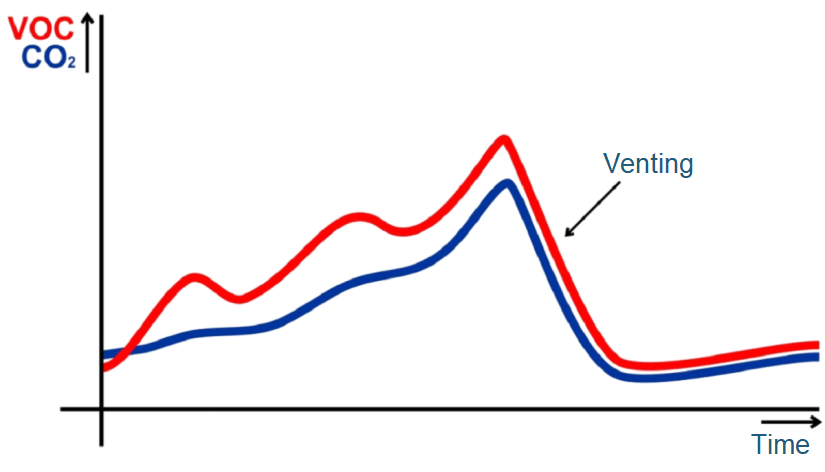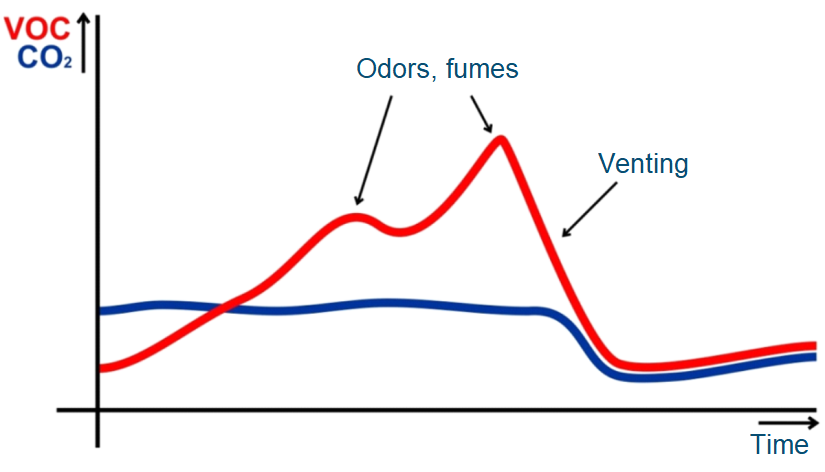Concept"VOC" or volatile organic substances arose from the English Volatile Organic Compounds.
(Volatile = volatile, i.e. at room temperature in a gaseous state).
People became more interested in air quality only in the second half of the last century, when more and more people began to appear in the indoor environment and for a longer period of time, who had unpleasant feelings such as fatigue, sleepiness, headaches, nausea or various manifestations of allergies – and all this is largely due to low air quality.
Whether we like it or not, the quality of the indoor environment is most negatively influenced by ourselves. Whether we take into account only the own breathing process or overall metabolic activity or even intensive physical activity in the given space. Therefore, the human body excretes other substances such as acetone, ethylene, methane, ammonia and many other types of volatile organic substances, which arise in the process of digesting organic food, through breath, sweat, transpiration through the skin, etc. All this depending on age, eating habits, state of health, general condition and, of course, current physical activity.
Of course, they can also be other no less significant sources of pollution outside of the person's own metabolic activity, basically we could say that we generate various other odors and odors through our activities, which are unpleasant and often harmful to health.
Other significant sources of VOCs include:
- cooking, frying and other technological processes
- coatings, adhesives
- cleaning and disinfecting agents
- furniture
- floor materials, carpets
- also scented candles, perfumes and cosmetics
In the last century, scientists estimated that there were approximately 5,000 volatile organic compounds. Today, with the addition of plastics, chemicals, adhesives, coatings, etc., their number is estimated at more than 10,000 different types.
Why, however, is air quality mainly assessed according to the CO2 concentration?
This is because the concentration of CO2 in exhaled air is roughly 50x higher than in inhaled air, i.e. a high concentration of CO2 clearly indicates that the air in a given space is exhaled and therefore also indicates a high concentration of VOCs.
Another reason is that, unlike a large number of different types of VOC substances, it is sufficient to monitor the concentration of only one substance - CO2, at a reasonable cost and with sufficient accuracy, which has a very good ability to tell us how the air in the given space is currently being exhaled and thus gives us clear information about the need for ventilation.
The fact that if the concentration of CO2 rises, so does the concentration of volatile organic substances is used to control ventilation. Like CO2 these are the result of the metabolic activity of the people who live in the space. And when ventilation starts, the concentration of both CO2 and VOC drops and we feel better, see the graph below:

For which premises is the VOC sensor suitable?
Of course, there are spaces where, despite the unpleasant sensations, the CO2 sensor would show low values, as it does not measure the very odors and odors that occur there and represent the primary pollution in the given space. Examples of such spaces can be:
- competitive, professional kitchen
- toilets
- dressing rooms
- gyms, fitness centers
- etc.
In such spaces, the dependence between CO2 and VOC can be, for example, the following:

Concept„TVOC“
This designation represents the so-called Total Volatile Organic Compounds (TVOC), i.e. a kind of summary of VOC substances in the monitored air. TVOC generally includes a wide range of different organic substances, which are often chemically very similar and difficult to distinguish, which has resulted in the creation of several different TVOC standards.
The characteristics of Protronix VOC sensors correspond to a combination of two recognized international standards, namely the EPA (Environmental Protection Agency - US Environmental Protection Agency) and UBA (UmweltBundesAmt - German Federal Environmental Agency) standards.
Concept"eCO2"
You may also come across the term eCO2 in connection with VOC measurement.
In order to be able to use VOC sensors in practice in a similar way to CO2 sensors, some Protronix VOC sensors have a so-called eCO2 output (estimated equivalent), which is an estimate of the CO2 concentration based on the currently detected VOC concentration. This estimate is based on the assumption that human-produced VOCs are proportional to exhaled CO2 (see Fig. 1).
In principle, this means that at such a CO2 concentration measured by a normal CO2 sensor, the air would contain a similar concentration of VOC substances as currently measured by the VOC sensor. This estimate is based on the assumption that human-produced VOCs are proportional to exhaled CO2.
It is then possible to work with the eCO2 output in the same way as with the signal from a standard CO2 sensor, which many installers are used to.
The article is prepared according to the information provided by Protronix, a Czech manufacturer of air quality sensors, further information, including the range of supplied sensors, can be found on their website cidla.cz .
 English
English